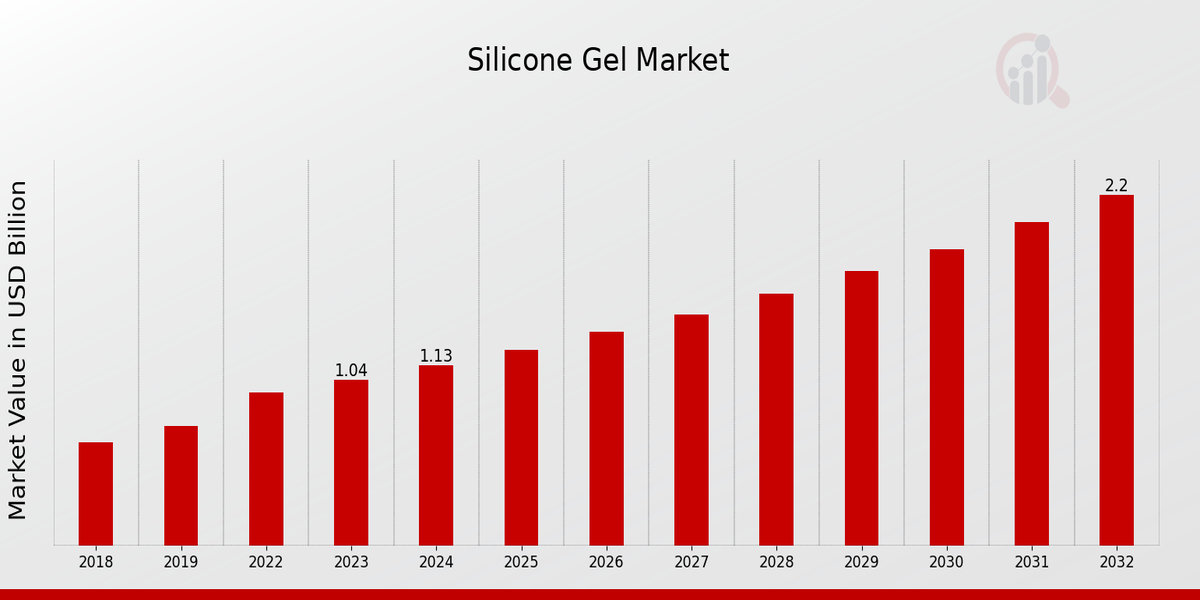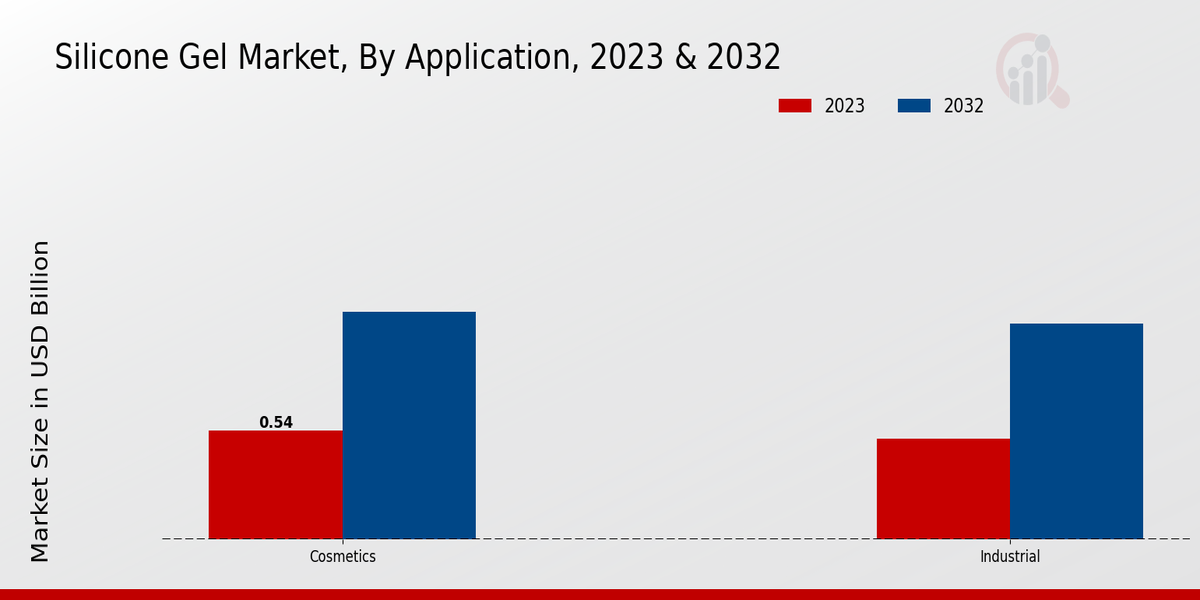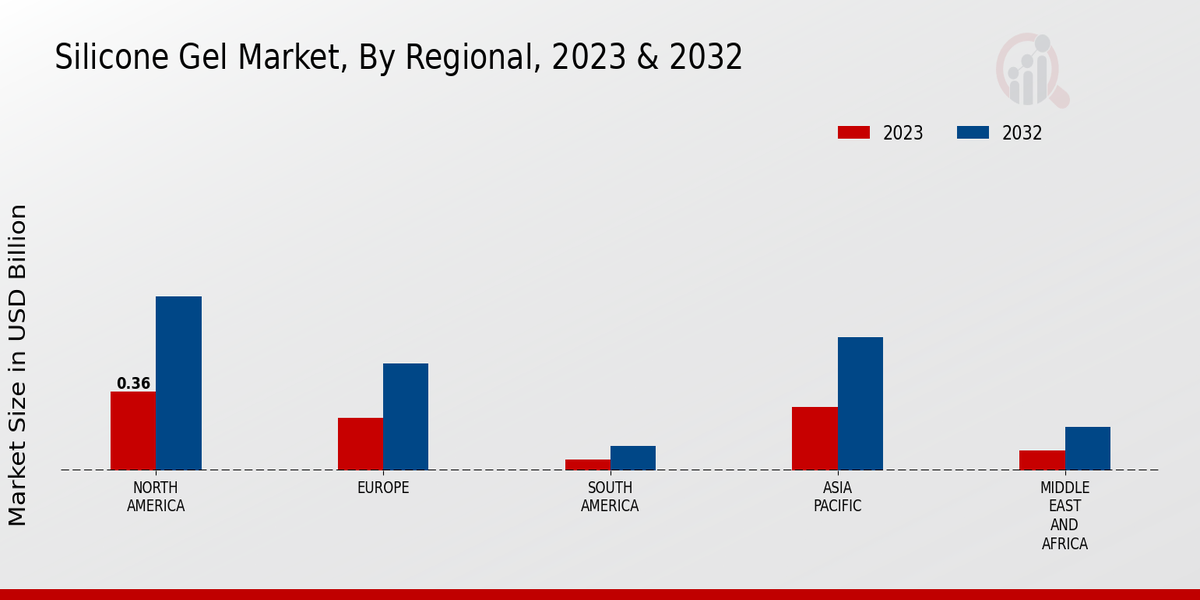Global Silicone Gel Market Overview
The Silicone Gel Market Size was estimated at 1.23 (USD Billion) in 2024. The Silicone Gel Industry is expected to grow from 1.34 (USD Billion) in 2025 to 2.82 (USD Billion) by 2034. The Silicone Gel Market CAGR (growth rate) is expected to be around 8.63% during the forecast period (2025 - 2034).
Key Silicone Gel Market Trends Highlighted
Key market drivers include rising demand from medical applications, increasing adoption in electronics, and growing awareness of silicone's properties in personal care.Opportunities in the market include expanding into emerging economies, developing new applications in renewable energy, and exploring innovative delivery methods.
Recent trends in the Silicone Gel Market include the emergence of silicone-based composites, advancements in microfluidics, and the growing use of silicone in 3D printing. These trends are shaping the market's evolution and creating opportunities for innovation and growth. By leveraging these drivers, opportunities, and trends, businesses can position themselves to capitalize on the growth potential of the Silicone Gel Market and meet the evolving needs of various industries.
Source: Primary Research, Secondary Research, MRFR Database and Analyst Review
Silicone Gel Market Drivers
Increasing Demand for Cosmetic Procedures
The demand for the Silicone Gel Market Industry is on the rise, with a particular increase seen in cosmetic procedures. Silicone gels are increasingly being utilized in breast implants, facial fillers, and a miscellaneous number of aesthetic augmentations. The various advantages associated with the application of the substance have led to customers’ heightened awareness in terms of safety features, the possibility to endure long-term use, and the resultant “natural look”.Concurrently, the increase in disposable income in both the developed and developing countries, along with the gradual growth in popularity of cosmetic applications, all contribute the boost of the market.
Advancements in Medical Technology
Advancements in medical technology are also fueling the growth of the Silicone Gel Market Industry. Silicone gels are increasingly used in medical devices and implants due to their biocompatibility, flexibility, and ability to mimic the properties of human tissue. For instance, silicone gels are used in catheters, stents, and wound dressings, providing better patient outcomes and reducing the risk of complications.
Growing Pharmaceutical Applications
The pharmaceutical industry is also a major driver of the Silicone Gel Market Industry. Silicone gels are used in the manufacturing of drug delivery systems such as patches, implants, and capsules. These drug delivery systems provide a controlled and targeted release of drugs and help reduce the side-effects of drugs and improve drug efficacy. The increasing need for targeted and personalized drug delivery systems is expected to be a major driver of the demand for silicone gels in the pharmaceutical industry.
Silicone Gel Market Segment Insights
Silicone Gel Market Application Insights
The Silicone Gel Market segmentation by Application includes Medical devices, Cosmetics, and Industrial. The Medical devices segment held the largest market share in 2023, and it will continue to be the market leader throughout the forecast period. The growth of this segment is attributed to the increasing demand for silicone gels in medical implants such as breast implants and joint replacements. The Cosmetics segment is expected to gain substantial growth over the forecast period owing to the growing trend of using silicone-based cosmetics such as primers, foundations, and mascaras.The Industrial segment will also have a steady growth rate throughout the forecast period as a result of the growing usage of silicone gels in electronics, automotive, and construction. Moreover, the rising awareness of the benefits of silicone gels, such as biocompatibility, durability and versatility, will also contribute to the growth of the market. Asia Pacific will be the most promising region in terms of growth over the forecast period owing to the increasing consumption of silicone gels for medical devices and cosmetics in countries such as China, India, and Japan.North America will also be a significant region, mainly due to the presence of a large number of manufacturers of medical devices and the growing interest in silicone gels in cosmetics. The European region will also have a steady growth rate over the forecast period. The Silicone Gel Market is a highly competitive market and has a substantial amount of players. Some of the major players in the market include Dow Corning, Momentive Performance Materials, Wacker Chemie AG, Shin-Etsu Chemical Co., Ltd., and Elkem ASA. Product innovation and a broader presence in other markets are crucial for these key players to maintain their position.
 Source: Primary Research, Secondary Research, MRFR Database and Analyst Review
Source: Primary Research, Secondary Research, MRFR Database and Analyst Review
Silicone Gel Market Chemical Composition Insights
The chemical composition of silicone gels can be segmented into polysiloxanes, silicone elastomers, and silicone resins. Polysiloxanes are the most common type of silicone gel and are composed of repeating units of (-Si-O-Si-O-)n. They are characterized by their high thermal stability, low surface energy, and biocompatibility. Silicone elastomers are cross-linked polysiloxanes that have been cured to form a solid material. They are known for their flexibility, durability, and resistance to chemicals and solvents. Silicone resins are hard, glassy materials that are formed by the condensation of polysiloxanes.The growth of the market is attributed to the increasing demand for silicone gels in various end-use industries, including healthcare, consumer products, and industrial applications. The healthcare industry is the largest consumer of silicone gels, accounting for over 50% of the market share. Silicone gels are used in a wide range of medical devices and implants, such as breast implants, catheters, and wound dressings. The consumer products industry is another major consumer of silicone gels, with applications in personal care products, cosmetics, and household items.Silicone gels are also used in a variety of industrial applications, such as sealants, adhesives, and coatings.
Silicone Gel Market Form Insights
The Form segment of the Silicone Gel Market is expected to exhibit significant growth over the forecast period, owing to the increasing demand for silicone gels in various applications. Sheets hold the largest market share due to their versatility and ease of handling. They are commonly used in medical applications, such as wound dressings and implants, as well as in industrial applications, such as gaskets and seals. Films are thin, flexible sheets that are often used as protective barriers or release agents. Blocks are solid, three-dimensional shapes that are used in a variety of applications, including construction, transportation, and electronics.Liquids are low-viscosity fluids that are used in a variety of applications, such as lubricants and adhesives. The Silicone Gel Market is expected to reach USD 1.04 billion in 2023 and USD 2.2 billion by 2032, exhibiting a CAGR of 8.63% during the forecast period.
Silicone Gel Market Strength Insights
The strength segment of the silicone gel market is categorized into high strength, medium strength, and low strength. Among these, high-strength silicone gels are expected to dominate the market, accounting for approximately 45% of the revenue in 2023. The demand for high-strength silicone gels is driven by their superior mechanical properties, such as high tensile strength, tear strength, and elongation at break. These properties make them suitable for various applications, including medical implants, aerospace components, and industrial seals.Medium-strength silicone gels hold a significant market share of around 30%, owing to their versatility and cost-effectiveness. They are commonly used in consumer products, such as cosmetics, personal care items, and electronic devices. Low-strength silicone gels, with a market share of approximately 25%, are primarily used in applications where flexibility and low modulus are required, such as in encapsulating delicate components and creating soft, cushioning materials. The market growth for all strength segments is influenced by factors such as rising demand from emerging economies, technological advancements, and increasing awareness of silicone gels' unique properties.
Silicone Gel Market Biocompatibility Insights
The biocompatibility segment of the Silicone Gel Market is expected to grow significantly in the coming years, driven by the increasing demand for biocompatible materials in medical and healthcare applications. Biocompatible silicone gels are well-tolerated by the human body and do not cause any adverse reactions, making them ideal for use in implantable devices, drug delivery systems, and tissue engineering. The increasing prevalence of chronic diseases and the rising adoption of minimally invasive surgical procedures are also contributing to the growth of the biocompatible silicone gel market.Their use is therefore limited to applications where biocompatibility is not a critical requirement, such as in industrial and consumer products. The market for non-biocompatible silicone gels is expected to grow at a slower pace compared to the biocompatible segment, owing to the increasing preference for biocompatible materials in medical and healthcare applications.
Silicone Gel Market Regional Insights
The Silicone Gel Market segmentation by Region is an important part of the market research. It gives insights into the market's geographical distribution and helps businesses understand the market dynamics in different regions. The regions covered in this segmentation are North America, Europe, APAC, South America, and MEA. North America is expected to dominate the market in 2024, with a revenue of USD 0.47 billion.
Europe is expected to be the second largest market, with a revenue of USD 0.32 billion. South America and MEA are expected to have moderate growth rates over the forecast period. The market growth in APAC is driven by factors such as increasing demand for silicone gels in medical, consumer, and industrial applications, rising healthcare expenditure, and growing awareness of the benefits of silicone gels.
 Source: Primary Research, Secondary Research, MRFR Database and Analyst Review
Source: Primary Research, Secondary Research, MRFR Database and Analyst Review
Silicone Gel Market Key Players And Competitive Insights:
All key players in the Silicone Gel Market are now engaged in the struggle for their own piece of market share and dominance, including the major ones. Leading Silicone Gel Market players are directing their efforts to the development of innovative silicone gel products and the broadening of their distribution networks. Among the major players, mergers, acquisitions, and the establishment of strategic contracts with other companies are also common to boost their position. In the short and longer time frame, the competitive landscape of the Silicone Gel Market will remain highly competitive and beneficial to business both due to the continuous innovation in the production of silicone gels and the expansion of markets.
Wacker Chemie is a key player in the Silicone Gel Market, producing superior silicone products. The company is not large by all industry standards in terms of the number of employees, but it has an enormous presence in multiple submarkets where different silicone products are used. Wacker Chemie works in the healthcare, automotive, construction, and other industries. The company is a large spender on research and development; it is responsible for tremendous amounts of innovation that serve its product line well. Wacker Chemie is a geographically diverse corporation, having numerous production sites and sales offices.
Another major player in the Silicone Gel Market is Momentive Performance Materials. The company produces silicones for different uses, including medical-grade gels, electronics encapsulants, and personal care ingredients. It is strong in the promotion of sustainability. There are remarkably few companies in the Silicone Gel Market having more intense sustainability programs than Momentive Performance Materials. The company has a well-established distribution network, with all the key distributors and resellers in place for the efficient delivery of all its products.
Key Companies in the Silicone Gel Market Include:
Silicone Gel Market Industry Developments
Rising demand for silicone gels in various industries, including healthcare, consumer products, and electronics, is driving market expansion. In healthcare, silicone gels are widely used in medical devices and implants due to their biocompatibility and durability. The increasing prevalence of chronic diseases and the growing geriatric population are contributing to the demand for silicone gels in medical applications.
Moreover, the expanding consumer electronics industry is also boosting market growth, as silicone gels are used in manufacturing components such as seals, gaskets, and coatings. Recent technological advancements, such as the development of high-performance silicone gels with enhanced properties, are further fueling market growth. Key players are focusing on strategic collaborations, acquisitions, and product launches to strengthen their market position and cater to the evolving demands of end-use industries.
Silicone Gel Market Segmentation Insights
Silicone Gel Market Application Outlook
-
Medical devices
-
Cosmetics
-
Industrial
Silicone Gel Market Chemical Composition Outlook
-
Polysiloxanes
-
Silicone Elastomers
-
Silicone Resins
Silicone Gel Market Form Outlook
-
Sheets
-
Films
-
Blocks
-
Liquids
Silicone Gel Market Strength Outlook
-
High strength
-
Medium strength
-
Low strength
Silicone Gel Market Biocompatibility Outlook
-
Biocompatible
-
Non-biocompatible
Silicone Gel Market Regional Outlook
-
North America
-
Europe
-
South America
-
Asia Pacific
-
Middle East and Africa
| Report Attribute/Metric |
Details |
| Market Size 2024 |
1.23 (USD Billion) |
| Market Size 2025 |
1.34 (USD Billion) |
| Market Size 2034 |
2.82 (USD Billion) |
| Compound Annual Growth Rate (CAGR) |
8.63% (2025 - 2034) |
| Report Coverage |
Revenue Forecast, Competitive Landscape, Growth Factors, and Trends |
| Base Year |
2024 |
| Market Forecast Period |
2025 - 2034 |
| Historical Data |
2020 - 2024 |
| Market Forecast Units |
USD Billion |
| Key Companies Profiled |
NuSil Technology, LLC, Elkem Silicones, Bluestar Silicones, The 3M Company, NuSil Technology., Wacker Chemie AG, Toray Industries, Inc., KCC Corporation, Kaneka Corporation, Momentive Performance Materials Inc., ShinEtsu Chemical Co. Ltd., Coatex, Sika AG, Dow, Evonik Industries AG |
| Segments Covered |
Application, Chemical Composition, Form, Strength, Biocompatibility, Regional |
| Key Market Opportunities |
Growing demand for wound care products Advancement of silicone technology Increasing usage in medical devices Rising prevalence of chronic wounds Expanding applications in personal care industries |
| Key Market Dynamics |
Rising demand for medical devices Increasing prevalence of chronic diseases Growing awareness of silicone gel benefits Technological advancements Expanding application areas |
| Countries Covered |
North America, Europe, APAC, South America, MEA |
Frequently Asked Questions (FAQ) :
The Silicone Gel Market is projected to reach USD 1.34 billion by 2025.
The Silicone Gel Market is expected to grow at a CAGR of 8.63% from 2025 to 2034.
North America is expected to dominate the Silicone Gel Market throughout the forecast period.
Key applications of Silicone Gel include medical implants, electronics, and personal care products.
Key competitors in the Silicone Gel Market include Dow, Wacker Chemie, and Shin-Etsu Chemical
Challenges faced by the Silicone Gel Market include stringent regulations and environmental concerns
Growth drivers of the Silicone Gel Market include rising demand from the medical and electronics industries.
The Silicone Gel Market is projected to reach USD 2.82 billion by 2034.
Silicone Gel is a synthetic material that can have negative environmental impacts if not disposed of properly
The Silicone Gel Market is subject to regulations governing the use and disposal of silicone-based materials.














